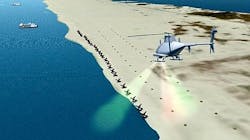Laser-based UAV sensor payload for detecting beach mines to be designed by BAE Systems
HONOLULU, 9 April 2013.Electro-optics designers at the BAE Systems Spectral Solutions segment in Honolulu are developing a prototype laser-based mine- and obstacle-detection system to help Navy and Marine Corps forces avoid threats on invasion beaches.
BAE Systems is developing the laser sensor for mine-detection prototype under terms of a $20 million contact announced Monday from the Office of Naval Research (ONR) in Arlington, Va.
BAE Systems is developing an advanced prototype system to detect mines and obstacles in the near-shore waters for the U.S. Navy and Marine Corps. The laser-based systems will provide 24-hour capability.
ONR scientists are asking BAE Systems to develop the prototype mine- and obstacle-detection system as part of the Coastal Battlefield Reconnaissance and Analysis (COBRA) program. For this contract BAE Systems engineers are adding capability for nighttime minefield and obstacle detection, as well as full detection of mines and obstacles in the surf zone as part of the COBRA program's Block II phase.
COBRA mounts an electro-optical sensor payload on a Navy MQ-8B Fire Scout unmanned helicopter deployed on the Littoral Combat Ship (LCS) or other surface vessels. The Fire Scout and its sensor payload search the littoral battle space for detecting and localizing mine fields and obstacles in the surf zone and beach zone, prior to an amphibious assault. COBRA will be part of the LCS Mine Countermeasures Mission Package.
The COBRA Block I program, which was tested and validated in 2010, is a passive system with capabilities of daytime surface-laid mine line and obstacle detection in the beach zone, limited detection capability in surf zone, and off-board processing.
The program's Block II will add nighttime minefield and obstacle detection capability and full detection capability in surf zone. Block III will add buried mine line detection capability and near real-time onboard processing.
This phase of the COBRA program capitalizes on BAE Systems laser detection technology. Work will be at BAE Systems facilities in Honolulu; Greenlawn, N.Y.; Acton, Mass.; and Hudson, N.H. BAE Systems Spectral Solutions is part of the BAE Systems Electronic Systems sector in Nashua, N.H.
For more information contact BAE Systems Electronic Systems online at www.baesystems.com, or the Office of Naval Research at www.onr.navy.mil.

